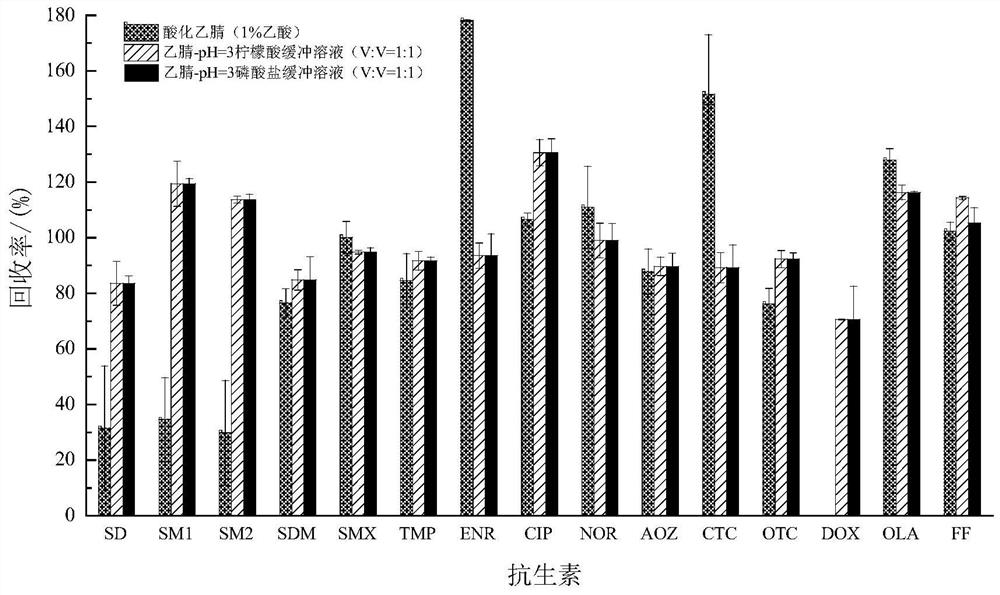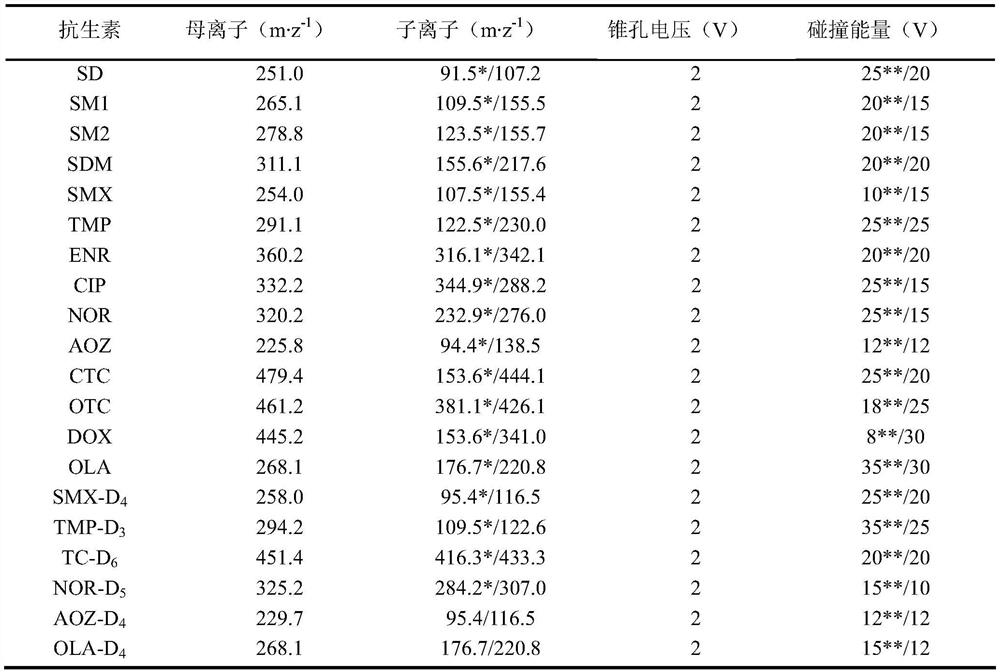Method for detecting 15 antibiotics in fish body
A technology for antibiotics and fish body, applied in the field of organic pollutant residue detection, can solve the problems of limited types and quantities of antibiotics, limited recovery rate, and many interferences, and achieve the effects of short extraction time, stable recovery rate, and low dosage.
- Summary
- Abstract
- Description
- Claims
- Application Information
AI Technical Summary
Problems solved by technology
Method used
Image
Examples
Embodiment 1
[0106] 1. Sample pretreatment
[0107] Wash the collected fish samples, absorb the surface moisture with gauze, dissect the back muscles of the fish, separate the fish skin, add the same quality of water to the fish samples, and then homogenize them. The treated samples are quickly placed at -20°C. Freeze until further extraction.
[0108] Weigh 5.00g of homogenized fish samples into a 30mL glass centrifuge tube, and add 100ng of sulfamethoxazole-D respectively. 4 , Trimethoprim-D 3 , Norfloxacin-D 5 , Furazolidone-D 4 , tetracycline-D 6 , Olaquindox-D 4 and florfenicol-D 3 The 7 internal standards were thoroughly mixed and allowed to stand in the dark for 10 min. Then add 10 mL of acetonitrile to the centrifuge tube and mix by vortex for 1 min. Acetonitrile can denature the protein and release the drug bound to it. Then add 10 mL of phosphate buffer with pH=3 and mix by vortex for 1 min. The buffer provides the target substance. In a relatively stable pH environment, ...
Embodiment 2
[0139] The matrix of fish meat samples is complex and contains compounds such as protein, fat, carbohydrate, inorganic salt and water. These sample matrices will affect the extraction efficiency of the analyte, cause errors in the detection results, and also contaminate the instrument, which directly affects the detection efficiency and accuracy. Therefore, in the analysis of veterinary drug residues, the pretreatment technology of the sample is very critical, and the main purpose is to separate the target compound from the sample matrix and remove interfering impurities. At the same time, there are many kinds of target antibiotics, and the physicochemical properties vary greatly. In order to maximize the extraction efficiency of various antibiotics in fish meat, the present invention adopts a single factor experiment to study the extraction effect of three different extraction solutions on the target substances.
[0140] Homogenized fish samples were obtained according to ste...
Embodiment 3
[0143] According to step 2 of Example 1, the mixed standard solution of 15 antibiotics was diluted with 70% methanol-water solution into a series of concentration gradients (1.37, 4.12, 12.35, 37.04, 111.11, 333.33, 500 μg·L -1 ), the internal standard is 100.0 μg·L -1 The concentration of 1 was added to the standard product, and the internal standard method was used to draw a 7-point standard curve with the concentration ratio of the component to the internal standard as the abscissa, and the response value (response value=target peak area / internal standard peak area) as the ordinate to draw a 7-point standard curve to obtain Standard curve and correlation coefficient (R 2 ). Meanwhile, the limit of detection and limit of quantification were determined by the signal-to-noise ratio (S / N) method, the limit of detection (LOD) was estimated by 3 times the signal-to-noise ratio, and the limit of quantification (LOQ) was estimated by 10 times the signal-to-noise ratio. The standa...
PUM
| Property | Measurement | Unit |
|---|---|---|
| pore size | aaaaa | aaaaa |
| pore size | aaaaa | aaaaa |
| correlation coefficient | aaaaa | aaaaa |
Abstract
Description
Claims
Application Information
 Login to View More
Login to View More - Generate Ideas
- Intellectual Property
- Life Sciences
- Materials
- Tech Scout
- Unparalleled Data Quality
- Higher Quality Content
- 60% Fewer Hallucinations
Browse by: Latest US Patents, China's latest patents, Technical Efficacy Thesaurus, Application Domain, Technology Topic, Popular Technical Reports.
© 2025 PatSnap. All rights reserved.Legal|Privacy policy|Modern Slavery Act Transparency Statement|Sitemap|About US| Contact US: help@patsnap.com



